Radiant vs Cushion Cut Diamond – What Are the Differences?
This is a question that I frequently get asked by consumers shopping for fancy shape diamond engagement rings – “What are the differences between radiant and cushion cut diamonds?”
Due to the similarities in outline they share, it can be confusing when making comparisons of radiant vs cushion cut diamonds. In this article, we will look at 2 key differences between them and also perform side by side comparisons for better visualization.
Finally, we will also reveal tips to help you select the best diamond for your ring and how you can get better value for money by shopping smart. Let’s dive in…
Key Difference #1 – Cut Corners vs Rounded Corners
While both the radiant cut and cushion cut can display similar outlines and table facet size, one easy way of telling them apart is to look at the corners of the stone. Radiant cut diamonds have distinct cut corners (usually at a slant of 45°) while cushion cut diamonds can be identified with curved edges.
Squarish radiant cut vs squarish cushion cut
Rectangular radiant cut vs rectangular cushion cut
Key Difference #2 – Technical Nomenclature Found in Grading Reports
If you are unsure about the type of diamond shape you are looking at, you can always find the corresponding information in the lab grading report. Look under the section of “Shape and Cutting Style” to get your answers.
Typically, cushion cuts are listed as “Cushion Brilliant” or “Cushion Modified Brilliant” depending on their facet structures. On the other hand, radiant cut diamonds are usually denoted as “Cut-Cornered Rectangular Modified Brilliant”.
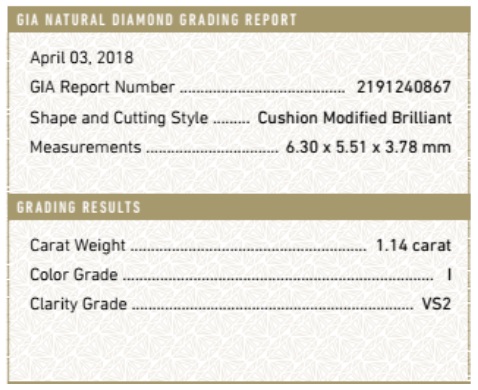
A typical description for cushion cut diamonds by GIA
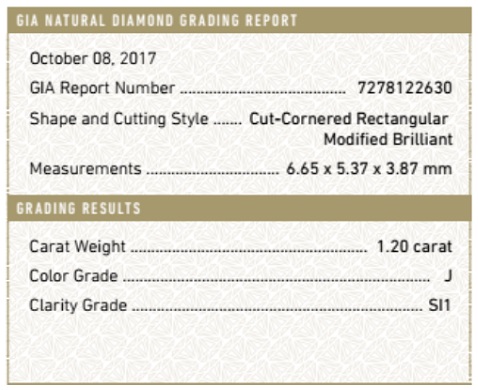
Note: The term radiant cut is coined by people in the trade. GIA labels these diamonds differently.
As you can see, the identity of a diamond will become obvious once you locate the corresponding information from the report. Here, I also want to highlight that there are other forms of cushion cut diamonds.
For example, modern branded cuts like the hearts and arrows Brellia and the vintage Old Miner cut can be listed under different cutting styles even though they are a sub-set of the cushion cut family.
Which One Sparkles More? The Radiant Cut or Cushion Cut?
The fundamental criteria which affects a diamond’s sparkle (light performance) is cut quality and not whether it is a radiant cut or a cushion cut. And like all other shapes of diamonds, cut quality is a variable which differs from one stone to another.
Here’s the thing, if you compare a well cut cushion diamond against a poorly cut radiant diamond, the cushion diamond is going to be brighter and more brilliant. On the other hand, if you were to compare a mediocre radiant vs an ideally cut cushion, the opposite holds true.
Cut quality matters. Cut makes all the difference between one diamond and can either make it look like frozen spit or one that sparkles like a disco ball.
The diamond on the left is poorly cut while the one on the right has ideal optics. I want you to click on the images above and interact with the 360 degrees video to look at the diamond’s scintillation patterning.
Should You Buy a Radiant or Cushion Cut Diamond Engagement Ring?
At the end of the day, your personal tastes will be the most important factor to consider when deciding between these two shapes. You may also want to consider the type of ring settings or style that you want to convey with the engagement ring.
For example, if you are aiming for a vintage style engagement ring, a cushion cut diamond would be a better fit compared to a radiant cut diamond. You may also want to read this article on the meanings that different cutting styles convey.
How to Save Money on Your Engagement Ring Purchase?
Most beginners don’t understand that high color and clarity ratings have little bearing on a diamond’s sparkle. One of the most common mistakes made is to assume that a D color, internally flawless diamond will yield the best looking stone.
The truth is far from that. If you shop with a misconception like this, you will only end up paying a huge premium for your engagement ring compared to someone else who shops smart.
Here are some practical tips to help you get the most out of your money when buying a radiant or cushion cut diamond ring. I recommend buying a G color diamond with SI1 or VS2 clarity that is eyeclean.
Doing so will easily save you 30-40% compared to buying a D/IF diamond and the point is, a well cut G/VS2 diamond will look identical to a D/IF diamond in the face up view. There’s absolutely no need to overpay for features your eyes can’t see.
The G SI1 diamond has better brilliance, better sparkle and patterning compared to the D IF diamond above. And the irony here is that, it actually costs less than half the price of the “perfect-on-paper” diamond.
Let’s Wrap Things Up
In summary, you can tell a cushion cut apart from a radiant cut by looking at the corners of the diamond. A cushion has rounded edges while a radiant cut diamond has straight slanted corners.
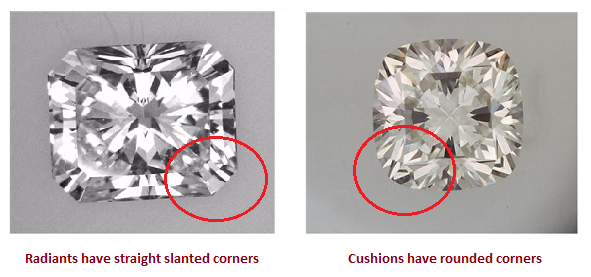
It is also important to note that fancy shape diamonds can exist in many variations and it is important to evaluate each stone based on their individual merits.
I hope this article has helped you in identifying the two different cutting styles correctly and offered insights into buying your dream diamond ring. If you have any questions, feel free to leave a comment below or get in touch via email directly.
Related Articles
Leave A Comment

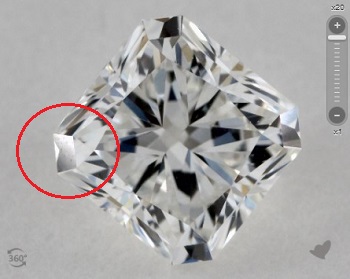
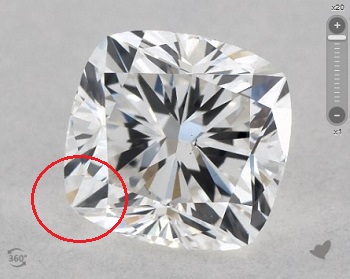
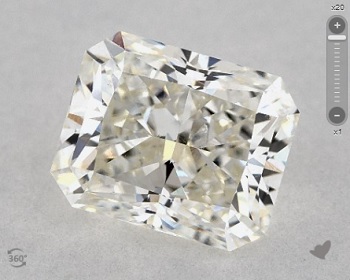
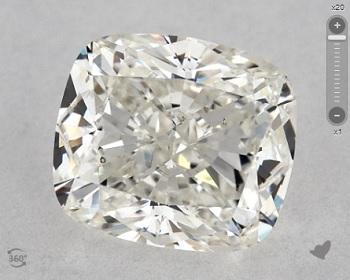
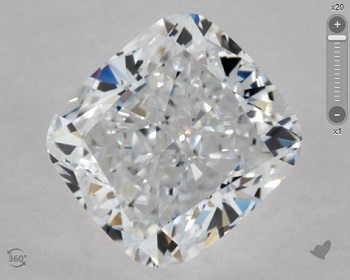
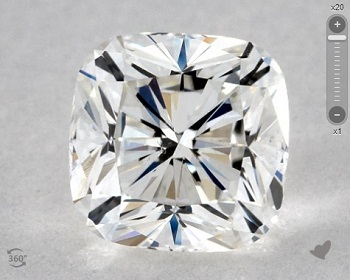
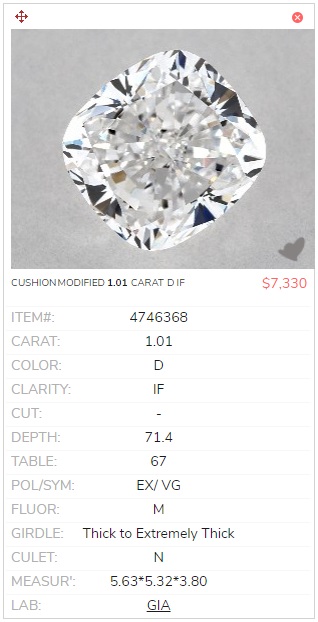
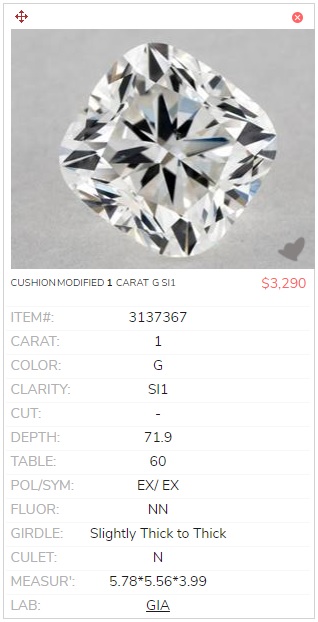
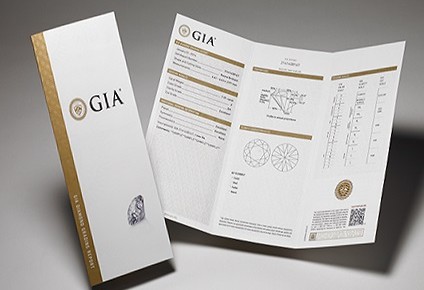
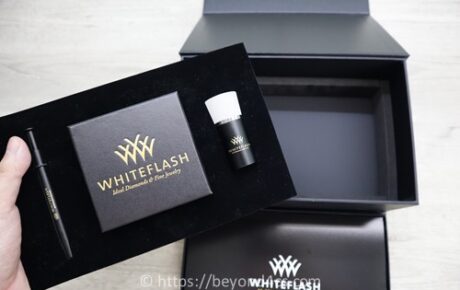

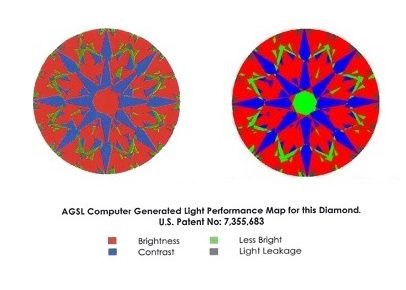






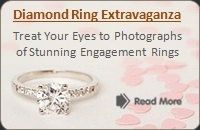
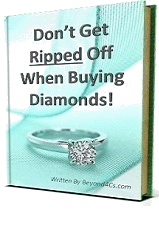

6 Comments
How important is the length to width ratio of the radiant cut diamond? I see some recommendations for 1:1.2 while some other people say that a 1:1 is the best. Also, what looks bigger cushion or radiant?
The length to width ratio only determines the outline of the diamond. Are you looking for a more elongated radiant cut or a more squarish radiant diamond? That is entirely up to your personal tastes. In the grand scheme of things, the length to width ratios doesn’t determine sparkle or how the diamond actually looks like. You will need to assess diamonds with tangible info to do that.
In general, I would say that the traditional radiant cut looks bigger than the cushion cut because of its elongated shapes. But really, it depends on a case by case basis and how the diamond is cut. A cushion cut can look bigger than a radiant cut if it was cut to lower depth % compared to a squarish radiant cut with steep proportions.
First off i sincerely appreciate the job you’ve done with beyond4cs.com. I’m a complete novice when it comes to diamonds, and after around 10 hours of research on the internet i came across you’re website, which was a one stop education in everything diamonds in a very clear and comprehensive manner.
I have a request if i may, if you can help suggest to me an engagement ring diamond (just the diamond) for my girlfriend, i’d sincerely greatly appreciate it.
I have discussed this with her so i’m pretty sure of her preferences.
My BUDGET for the loose diamond alone is between $2000-2500.
Unless in your opinion it is an impractical price, In which case i’d be ready to borrow a few hundred dollars to get a (relatively) respectable diamond up to $3000.
the same applies if going up to $3000 would be of disproportionate benefit to the beauty of the diamond.
Here are the preferred characteristics of the diamond in order of preference.
1. SHAPE – Rectangular radiant cut, it should be an obvious rectangle, i’d say 1.20-30 1 ratio is ideal but as long as it’s clearly rectangular and not an awkwardly long rectangle it’s good.
2. CUT – the best cut possible / practical
3. CARAT SIZE – i do not value rounded number milestones, so after taking into account the best cut, the bigger top DIMENSIONS the better, i’d prefer no smaller than around a width of 4.9 mm and a length of 6.5 mm.
4. COLOR – the more colorless the better but as long as an average person can’t easily detect color it’s of lower preference than size.
5. CLARITY – although this is lowest in preference it’s only so in terms of clarity grades, i do not value clarity grades. But i do greatly value even more than diamond size that it should be eye clean that with the naked eye an untrained viewer would not be able to detect any obvious blemishes/inclusions.
I hope i’ve been specific enough please let me know if not.
Thanks for getting in touch and leaving a very clear set of specifications of the ring you are looking for. Based on your budget and specs, I did a comprehensive search for you and would recommend these diamonds:
https://www.jamesallen.com/loose-diamonds/radiant-cut/0.98-carat-f-color-si1-clarity-sku-4944211
https://www.jamesallen.com/loose-diamonds/radiant-cut/1.01-carat-h-color-vs2-clarity-sku-4602589
Both diamonds are eyeclean and these are the 2 best diamonds across different inventories. They exhibit very strong light return as well. Go for the 2nd option if you want to stay strictly within budget. If you don’t mind the small increase in price, the F diamond offers great value for money.
thank you very much. i can see (i think) the brilliance of those ones come across through the screen.
just a follow up couple of general questions.
1. in this suggestion https://www.jamesallen.com/loose-diamonds/radiant-cut/0.98-carat-f-color-si1-clarity-sku-4944211
would the fact that the girdle fluctuates from thin to very thick be of any issue in a raised setting?
2. is it in general a sound strategy to try to maximize value by filtering results to the lower part of the ideal depth% spectrum and higher part of the table%
this way maximizing visible dimension per carat? (i understand its possible that this is utter gibberish please let me know if so)
3. do you have an opinion on the website Yadavjewlery.com? they don’t always have 360 views but usually yes and sometimes even ASET imagery
thank you very much. i don’t know why you do this but i think it’s pretty awesome.
It’s a hobby and passion for gemstones. Plus, when there are more happy readers, it equates to more referrals in future via word-of-mouth and that drives traffic. I take a very long term view for Beyond4cs.com and you can find out more about why i do this here: https://beyond4cs.com/about/ftc-disclosure/
A thin to very thick girdle is perfectly fine for radiant cuts. There are not that much fluctuations contrary to what you think. That’s because of the very good symmetry rating which takes into account any of such severe variations in girdle thickness.
FYI, Very Good and Excellent symmetry ratings are perfectly fine for fancy shapes. Your girdle fluctuations will only be a possible concern if the diamond had a Poor symmetry rating which tells me that the facets are poorly placed.
But rest assured that it isn’t in your case. If there was any issue, I won’t have recommended the 2 diamonds.
For the kind of size you are looking at, you need to get closer to 1 carat in size. And the F diamond fits that perfectly.